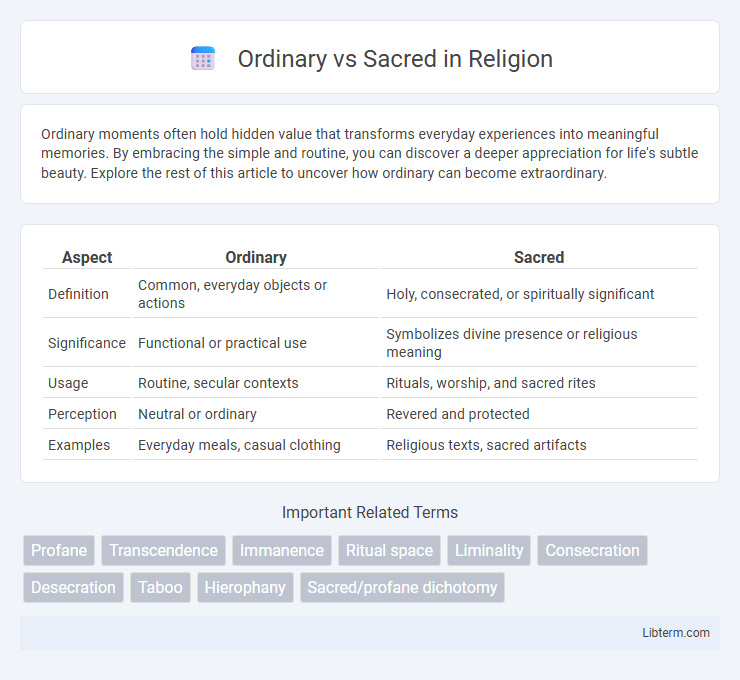Ordinary moments often hold hidden value that transforms everyday experiences into meaningful memories. By embracing the simple and routine, you can discover a deeper appreciation for life's subtle beauty. Explore the rest of this article to uncover how ordinary can become extraordinary.
Table of Comparison
| Aspect | Ordinary | Sacred |
|---|---|---|
| Definition | Common, everyday objects or actions | Holy, consecrated, or spiritually significant |
| Significance | Functional or practical use | Symbolizes divine presence or religious meaning |
| Usage | Routine, secular contexts | Rituals, worship, and sacred rites |
| Perception | Neutral or ordinary | Revered and protected |
| Examples | Everyday meals, casual clothing | Religious texts, sacred artifacts |
Understanding the Concepts: Ordinary vs Sacred
Understanding the concepts of ordinary and sacred involves recognizing the distinction between everyday, mundane experiences and those imbued with special meaning, significance, or spirituality. Ordinary refers to routine, common occurrences lacking symbolic or ritualistic value, while sacred denotes elements considered holy, revered, or set apart due to religious, cultural, or emotional importance. This conceptual dichotomy shapes human perception by influencing rituals, practices, and the attribution of deeper purpose to certain objects, places, or moments.
Historical Perspectives on the Sacred and the Everyday
Historical perspectives on the sacred and the everyday reveal a dynamic interplay where sacred spaces, rituals, and objects were often distinguished from the mundane through symbolic meanings and social functions. In ancient civilizations, such as Mesopotamia and Egypt, temples and religious ceremonies structured communal life, elevating certain times and places as sacred while ordinary life occurred outside these sacred boundaries. Modern scholarship highlights how this dichotomy has evolved, with some traditions blurring lines between sacred and secular, reflecting ongoing cultural interpretations and the social construction of holiness in everyday experiences.
Characteristics of Ordinary Experiences
Ordinary experiences are characterized by their routine nature, predictability, and lack of extraordinary significance, often involving daily activities such as walking, eating, and working. These experiences are grounded in the physical and temporal world, emphasizing practicality and repetition without invoking deeper meaning or spiritual reflection. They serve as the baseline of human perception, contrasting sharply with sacred experiences that transcend the mundane through symbolism, awe, and transcendence.
Defining Sacred Moments and Spaces
Sacred moments and spaces are defined by their intentional separation from ordinary experiences through rituals, symbolism, and a deep sense of reverence. These spaces often evoke feelings of transcendence, connection to the divine, or heightened awareness, distinguishing them from everyday environments. The contrast between ordinary and sacred hinges on the meaning attributed by cultural, spiritual, or personal significance, transforming routine moments into profound experiences.
The Role of Culture in Shaping Sacredness
Culture profoundly influences the perception of sacredness by defining rituals, symbols, and places that distinguish the ordinary from the holy. Sacredness is often constructed through collective beliefs and practices that assign meaning and reverence to objects, events, or spaces within a community. These cultural frameworks create a shared understanding of what is sacred, shaping social cohesion and identity.
Rituals: Bridging Ordinary and Sacred Worlds
Rituals serve as dynamic bridges linking the ordinary and sacred worlds by transforming everyday actions into meaningful, symbolic practices. These ceremonies imbue routine behaviors with spiritual significance, creating a liminal space where participants experience connection to the divine or transcendent realm. By repeating prescribed rites within specific cultural or religious contexts, rituals reinforce communal identity and facilitate personal and collective access to sacred dimensions.
Psychological Impact: Sacredness in Daily Life
Sacredness in daily life creates a psychological impact by fostering mindfulness and a deeper sense of purpose, which enhances emotional well-being and reduces stress. Ordinary moments transformed into sacred experiences promote gratitude, strengthen personal identity, and facilitate spiritual connection, leading to increased resilience and mental clarity. This distinction between ordinary and sacred encourages individuals to find meaning in routine activities, improving their overall psychological health and life satisfaction.
Transformation: When the Ordinary Becomes Sacred
Transformation occurs when ordinary experiences or objects gain sacred significance through ritual, belief, or cultural meaning, elevating them beyond daily life. This shift redefines perception and behavior, creating profound connections between individuals and the sacred realm. Sacredness imbues the ordinary with spiritual or symbolic power, fostering identity, community, and transcendence.
Modern Challenges: Preserving the Sacred
Modern challenges in preserving the sacred revolve around rapid urbanization, technological advancements, and cultural globalization that often dilute traditional spiritual practices. Increasing secularization and commercialization threaten the integrity of sacred sites, rituals, and symbols, making it difficult to maintain their original meaning and significance. Effective preservation strategies demand community engagement, legal protection, and sustainable practices that respect both ordinary lifestyles and sacred heritage.
Embracing Sacredness in a Secular Society
Embracing sacredness in a secular society involves recognizing the deeper meaning and reverence found in everyday experiences, transcending the purely ordinary aspects of life. This approach encourages individuals to cultivate mindfulness, ritual, and intentionality to transform routine actions into moments of spiritual significance. Integrating sacred practices fosters a sense of connection and purpose without reliance on formal religious frameworks.
Ordinary Infographic

 libterm.com
libterm.com